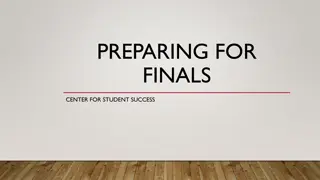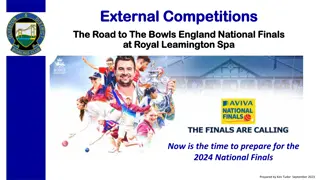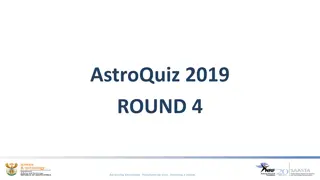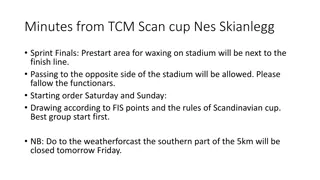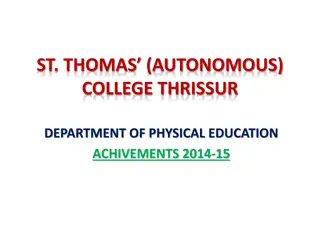SAASTA AstroQuiz 2018 National Finals Overview
The SAASTA AstroQuiz 2018 National Finals is a competitive event where teams must answer astronomy-related questions. The quiz has specific rules, including maintaining silence, time limits for answers, and audience participation for prizes. Questions cover topics such as lunar eclipses, celestial bodies, and more. The event culminates in an awards function to announce the winners. Viewers can engage with challenging queries and witness a thrilling quiz competition.
Download Presentation

Please find below an Image/Link to download the presentation.
The content on the website is provided AS IS for your information and personal use only. It may not be sold, licensed, or shared on other websites without obtaining consent from the author. Download presentation by click this link. If you encounter any issues during the download, it is possible that the publisher has removed the file from their server.
E N D
Presentation Transcript
WELCOME to the SAASTA AstroQuiz 2018 NATIONAL FINALS
RULES OF THE QUIZ The audience must be silent throughout the quiz and NOT whisper to anyone. No resource material can be taken into the quiz venue. Teams have up to 1 minute to discuss each answer and must reveal their answers immediately when the signal is given that the time is up. The scores will be calculated and given after THE FIRST ten questions ONLY and overall winners will be announced at the Awards function in the evening. The audience will get a chance to win prizes! A tie-break will be settled on a sudden death basis, involving tied teams only (i.e. as soon as a team falls behind on correct answers, it is knocked out).
QUESTION 1 The longest lunar eclipse of the 21stcentury took place on this date. A. 27 June 2018 B. 31 July 2018 C. 27 July 2018 D. 31 June 2018
QUESTION 2 During what time of the day did this eclipse occur? A. Day B. Night C. Morning D. Noon
QUESTION 3 During that eclipse, what was the colour of the Moon? A. Very dark B. Blood red C. Blue D. Black
QUESTION 4 During this eclipse period, there was a certain planet that was seen close to the Moon. Which planet was that? A. Earth B. Venus C. Mars D. Saturn
QUESTION 5 Because this planet was close to the Moon in the sky, its purpose was ____ A. To give the Moon the blood red colour B. To keep the Moon in its place during the eclipse C. To support the Moon, the Earth and the Sun during the eclipse D. None of the above
QUESTION 6 The diameter of the Moon is 3 475 km. If a soccer field is 100 m long, how many soccer fields will fit in the Moon s diameter? A. 3 475 000 B. 347 500 C. 34 750 D. 3 475
QUESTION 7 The Moon shows the same side to Earth during its orbit. A. True B. False
QUESTION 8 I. II. III. IV. More than 100 spacecraft have been launched to explore the Moon. It s the only celestial body beyond Earth visited by human beings. The moon is the brightest and largest feature in the night sky. The Moon is a rocky, solid-surface body with much of its surface cratered and pitted from impacts. Which of the above is true about the Moon? A. All 4 facts; B. I & IV; C. II & III; D. II, III & IV
QUESTION 9 In which year did South Africa win the bid to host the Square Kilometre Array (SKA)? A. 2010 B. 2011 C. 2012 D. 2013
QUESTION 10 The Karoo Array Telescope 7(KAT-7) is a forerunner of the MeerKAT which is the forerunner of the eventual SKA. A. True B. False
QUESTION 11 An Observatory is a______ A. a group of telescopes B. place/structure with equipment to observe celestial events/bodies C. a telescope used to observe planets, stars and other celestial bodies D. an act of observing
QUESTION 12 The largest verified and one of the oldest impact crater on Earth is the ____ crater. A. Tswaing B. Kalkkop C. Vredefort D. Morokweng
QUESTION 13 This crater is situated in the ________ A. Free State province of South Africa B. North West province of South Africa C. United States of America D. Northern Cape province of South Africa
QUESTION 14 The nearest planet to the Sun with more than one moon is ______ A. Mercury B. Mars C. Saturn D. Jupiter
QUESTION 15 How many moons does this planet in Question 14 above have? A. 2 B. 16 C. 23 D. 64
QUESTION 16 The nearest planet to the Sun with rings is_____ A. Neptune B. Mars C. Jupiter D. Saturn
QUESTION 17 The brightest star in the sky, Sirius, is/was____ A. B. C. D. Closest to the Earth Whiter and hotter than the Sun Blue and cold Discovered by Robert Innes in 1915
QUESTION 18 Which of the following objects is the smallest of them all? A. Star B. Galaxy C. Solar system D. Planet
QUESTION 19 Tswaing, Vredefort, _____ and ____ are impact craters. A. Mankweng and Vredekop B. Morokweng and Kalkkop C. Morokweng and Mankweng D. Mankweng and Kalkkop
QUESTION 20 The impact craters mentioned in Question 19 above are found in ____ provinces respectively. A. Gauteng; Northern Cape; Free State and Western Cape B. Gauteng; Free State; Eastern Cape and North West C. North West; Free State; North West and Eastern Cape D. Gauteng; Free State; North West and Eastern Cape
QUESTION 21 Which planet has the longest day of all the planets in the solar system? A. Saturn B. Mercury C. Venus D. Jupiter
QUESTION 22 The most abundant metal element in the Earth is _____ A. Iron B. C. D. Oxygen Nitrogen Gold
QUESTION 23 The most abundant gas in Earth s atmosphere is _____ A. B. C. D. Iron Oxygen Nitrogen Gold
PLEASE REFER TO THE PICTURE PROVIDED TO ANSWER QUESTIONS 24 - 30
QUESTION 24 What event is represented by picture A provided? A. Super moon B. Eclipse C. Ellipse D. Burning Sun
QUESTION 25 The diameters of the Earth and the Moon are approximately 12 756 and 3 475 km respectively. How many times bigger is the Earth than the Moon? A. 0.27 B. 9 281 C. 3.76 D. 3.67
QUESTION 26 During what time of the day can we see/view this event? A. Day B. Night C. Only at sunset D. Midnight
QUESTION 27 During this event ________. A. the Moon moves in its orbit between Earth and the Sun B. the Earth moves in its orbit between Moon and the Sun C. the Sun moves in its orbit between Earth and the Moon D. the Moon moves in its orbit between Mars and the Sun
QUESTION 28 This event happens only during ______ A. Full Moon B. New Moon C. First Quarter D. Last Quarter
QUESTION 29 If the Moon was moving in the same plane as Earth and Sun, then such an event would take place about once _____ A. Day B. Month C. Year D. Century
QUESTION 30 If the Earth has a diameter of 12 756 kilometres, what will its circumference (C) be in kilometres? NB: C = 2 r , pi ( ) = 3.14; r is radius. A. 4,0054 x 104 B. 4,0054 x 105 C. 4,0054 x 106 D. 40,0054 x 107
SUDDEN DEATH TIE BREAKERS
PLEASE REMEMBER: The first team to get the correct answer is the winner! ALL THE BEST!
QUESTION 1 The diameters of Sun, Jupiter and Earth are approximately 1 391 000, 142 984 and 12 756 km respectively. How many times bigger is the Sun than Jupiter and Earth respectively? A. 9.73 and 109 B. 1 248 016 and 1 378 244 C. 0.10 and 0,01
QUESTION 2 The brightest star in the sky, Sirius, is/was____ A. Closest to the Earth B. Whiter and hotter than the Sun C. Blue and cold D. Discovered by Robert Innes in 1915
QUESTION 3 Which of the following is the most accurate statement about the seasons? A. Seasons occur because the Sun goes around the Earth and the Moon around the Earth B. Seasons occur because the Earth goes around the Sun C. Seasons occur because the Earth goes around the Sun and its axis is tilted at 23.50to the plane of its orbit D. Seasons occur because the Earth s orbit brings it nearer and further away from the Sun
QUESTION 4 Which one of the following is true? A. A galaxy is made of a few collection of stars held together by gravity B. None of the stars in a galaxy have common gravity C. Galaxies contain stars only D. A galaxy is a collection of many stars, gas and dust which are held together by gravity
QUESTION 5 Ordered by decrease in diameter, which sequence will be correct? A. Pluto, Haumea, Ceres B. Pluto, Ceres, Haumea C. Ceres, Pluto, Haumea D. Ceres, Haumea, Pluto
QUESTION 6 Which of the following lists has the objects arranged with decreasing diameter? A. Earth s Moon, Pluto, Mars, Mercury B. Mars, Mercury, Earth s Moon, Pluto C. Mercury, Mars, Earth s Moon, Pluto D. Pluto, Earth s Moon, Mercury, Mars
QUESTION 7 If the planets Venus, Earth and Mars are arranged according to decrease in day lengths, what will the sequence will be? A. Venus, Earth, Mars B. Mars, Venus, Earth C. Earth, Mars, Venus D. Venus, Mars, Earth
QUESTION 8 The largest moon in the solar system is ______ A. Titania, a moon of Uranus B. Ganymede, a moon of Jupiter C. Titan, a moon of Saturn D. the Moon
QUESTION 9 When a star shrinks due to lack of fuel, it will shrink into a ______ star. A. Dwarf B. Supernova C. Neon D. Blue
QUESTION 10 Which planet is called the red planet? A. Mercury B. Mars C. Venus D. Earth
QUESTION 11 The planet in Question 10 above has a red colour because _____ A. It has been named after the Roman god of war B. It is covered with iron oxide dust C. It has a mixture of mud & water which gives it the red appearance D. of the reflection of light from the Sun
QUESTION 12 What is the name of the optical telescope that will collaborate with MeerKAT. A. SALT B. HESS C. Meerlicht D. KAT-7
QUESTION 13 How old will Astronomy research be in South Africa by the year 2020. A. 50 B. 100 C. 200 D. 300






